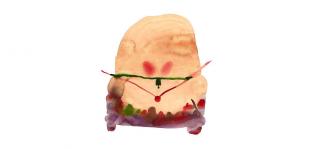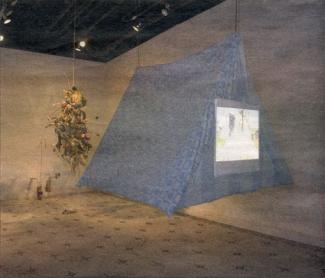An exhibition review from Georgia Straight:
Walk into the Access Artist Run Centre and you are happily assaulted by antic energy. The Composition Kids is a smile-inducing installation that melds sound, movement, sculpture, and video. Created by Vancouverites Julia Feyrer and Pietro Sammarco, it riffs on the contemporary garbage aesthetic and the creative possibilities of junk. It also improvises on ideas of travel, nomadism, and the nature of home.
The installation originated in the duo's scavenging of discarded objects while touring as members of the local art band They Shoot Horses Don't They?. As the exhibition brochure explains, Feyrer and Sammarco picked up bits of detritus during their travels-"pipes, tin cans, badminton birdies, dead modems, broken cruthes" - and incorporated them as musical instruments in their performances. Eventually, as they moved the place to place, all thes bits and pieces of junk coalesced into a big, ungaingly "trumbleweed", an assemblage sculpture that now hangs from the ceiling at Access.
Comprising everything from wooden shoes, metal beads, and pine cones to plastic tubing, bicycle parts, and crushed licence plates, all tied together with ropes and twine, this sculpture has both audio and kinetic aspects. Strings attach it to two wooden feet that "walk" on the tile floor with a clopping sound. As the feet move up and down, driven by a small whirring motor, they jerk the strings, causing the assemblage to shudder, clink and jingle. It's like a cross between the kinetic sculptures of Jay Johnson and the huge assemblages that Carole Itter has long produced out of painted found objects. Feyrer and Sammarco's aesthetic, however, is less elegant and unified than Johnson's or Itter's, and more deliberately chaotic and humorous.
At the front of the gallery, a short 16mm film, coverted to DVD, is projected onto a pup tent. (The tent is constructed from old bed sheets and is also suspended from the ceiling.) The soundtrack here is a wonderful conglomeration of music improvised on unlikely instruments, echoing the tumbled-together effect of the assemblage. As the camera records the duo's travels around Sicily, Sammarco's ancestral home, a series of percussive, string, and horn sounds emerges to contradict and complement the action. Scenes include impromptu installations and performances in a variety of sites, including the ruins of old villages, abandoned after a 1968 earthquake. Such sites function as a place to contemplate home and travel, security and displacement, comfort and catastrophe.
Performance art, multimedia installations, noise art, and found art all have their origins in the Dadaism of the early 20th century. When the Dadaists began deploying garbage and debris as media, their intention was to challenge bourgeois ideas about art and aesthetics. More than 90 years later, when the bourgeois find Dadaism adorably picturesque, artists who create work out of junk are issuing another kind of challenge-even if it's unconscious. They're calling us to task for the vast, indiscriminate waste that is the arseend of global overconsumption.

